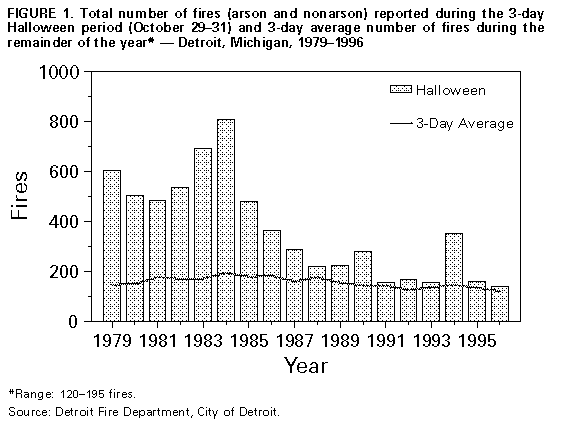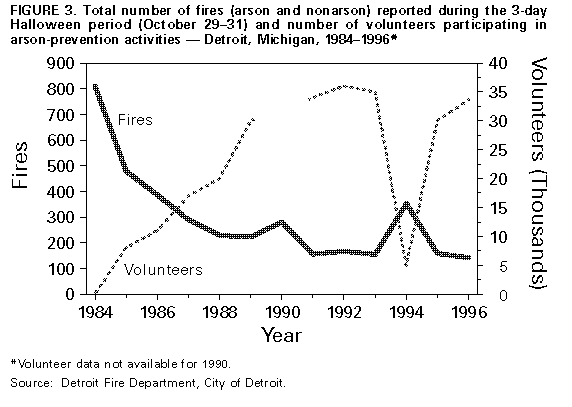 |
|
|
|
|
|
|
| ||||||||||
|
|
|
|
|
|
|
||||
| ||||||||||
|
|
|
|
|
Persons using assistive technology might not be able to fully access information in this file. For assistance, please send e-mail to: mmwrq@cdc.gov. Type 508 Accommodation and the title of the report in the subject line of e-mail. Urban Community Intervention to Prevent Halloween Arson -- Detroit, Michigan, 1985-1996Arson, the second leading cause of residential fire-associated deaths in the United States, accounts for approximately 700 deaths annually, destroys homes, and destabilizes neighborhoods (1-3). In Detroit, Michigan (1990 population: 1,027,974), arson accounted for nearly half (46.3%) of all fire-related deaths since 1984 (4). During the late 1970s, pre-Halloween pranks traditionally associated in some parts of the United States with the night of October 30 turned destructive in Detroit, with hundreds of fires set throughout the city. By 1984, October 30 became known as "Devil's Night" and had evolved to 3 consecutive nights of arson on October 29-31; in that year, a record 810 fires were reported (5). In 1985, Detroit began a citywide intervention campaign against arson and vandalism during the 3-day Halloween period using data from an ongoing fire surveillance system maintained by the Detroit Fire Department (DFD) to target areas at high risk for arson. This report describes the intervention implemented by the city of Detroit from 1985 through 1996 and the impact of the intervention in preventing Halloween arson; approximately 34,000 volunteers participated in 1996 (6), and the number of fires during this 3-day period decreased to the average number of fires for any other 3-day period during the remainder of the year. Intervention Design Since 1985, the annual citywide antiarson intervention has been developed and implemented by the Anti-Arson Initiative Steering Committee (comprising representatives from city government departments and agencies, community organizations, and the private sector). Information from previous intervention programs and fire incidence data obtained from the Detroit Fire Incident Reporting System (DFIRS) were used to plan the annual antiarson intervention (7,8). Information in the DFIRS database is obtained from incident and casualty reports documenting the nature of each incident to which the DFD responds; date, time, and location of occurrence; probable cause; associated injuries and/or fatalities; and other information. The DFD Arson Section investigates a proportion of "incendiary" (i.e., confirmed) or "suspected" arson fires, including all multiple alarm fires and those that involve a death or injury, criminal activity, occupied dwelling, or explosion. From 1985 through 1996, DFIRS information was used to monitor annual and monthly trends in fire incidence and to plot maps detailing the location of fires reported during the previous year, by type, in each census tract within the metropolitan area. The steering committee used these maps, along with Detroit Police Department maps indicating the location of various crimes committed during the previous year, to 1) identify areas at high risk for Halloween arson and vandalism, 2) develop volunteer deployment plans, 3) estimate equipment and supply requirements, 4) prioritize areas for demolition of vacant buildings, and 5) determine the location of temporary DFD command posts during Halloween. Staff at nine neighborhood city halls, 13 police precincts, and nine fire battalions coordinated decentralized action plans complementing the overall city plan. The antiarson intervention implemented by the city of Detroit from 1985 through 1996 included eight key elements. First, all available city firefighters were stationed at strategically located DFD command posts, and police officers and other city employees patrolled designated areas of the city. Second, potential arson targets were eliminated or reduced by demolishing abandoned buildings, towing abandoned vehicles, removing tires from dump sites, and emptying large trash receptacles. Third, city residents were recruited to serve as volunteers from community organizations, religious groups, schools, unions, and the private sector. Fourth, volunteers received orientation for guarding abandoned neighborhood buildings, patrolling designated neighborhoods in vehicles, providing administrative support at operational centers throughout the city, and keeping outdoor lights on throughout the night. Fifth, an aggressive education/public relations campaign informed residents about Halloween antiarson intervention plans, the dangers of arson, and suggestions for preventing arson. Sixth, structured activities for children and teenagers -- including movie marathons, teen dances, overnight slumber parties, carnivals, and other activities -- were sponsored by the city of Detroit, community organizations, churches, and other groups. Seventh, Detroit's year-round youth curfew was extended to begin at 6:00 p.m. on October 30 and continue through 6:00 a.m. on October 31 for youth aged less than or equal to 17 years unaccompanied by an adult. Finally, since 1995, an emergency city ordinance has prohibited the dispensing of fuel into portable containers, except in certain emergency circumstances, during Halloween. Fire Trends and Fire-Related Deaths, 1979-1996 Following an increase in the number of total Halloween fires from 1979 through 1984, the number of Halloween fires reported annually declined from 810 in 1984 to 142 in 1996 (Figure_1). From 1991 through 1996 (with the exception of 1994), the number of Halloween fires ranged from 142 to 167, within the range of the number of fires expected to occur during any 3-day period in Detroit (Figure_1). From 1979 to 1996, an average of 61.2% of annual Halloween fires were classified by DFD personnel as confirmed or suspected arson. For 1995, of 158 Halloween fires, 86 (54.4%) were arson-related, compared with 6572 (41.1%) of 15,971 total fires. From 1979 through 1984, the number of arson-related Halloween fires increased from 341 to 582, with an overall decrease to 84 in 1996 (Figure_2). Before 1985, most Halloween arson fires were refuse fires. From 1983 to 1984, the number of arson-related building fires increased nearly fourfold, from 45 to 170 fires, and since 1985, the greatest proportion of Halloween fires have occurred in buildings (Figure_2). Annual fire-related fatalities in Detroit have decreased since 1979, ranging from 107 deaths in 1979 to 44 deaths in 1996. From 1984 through 1996, arson accounted for an average of nearly half (47.4%) of all fire-related deaths each year. The number of youth curfew violations decreased from 315 in 1994 to 185 in 1996. Except for 1994, the number of volunteers participating in the annual antiarson campaign increased annually from 1985 through 1996, from approximately 8000 to 33,615 (Figure_3). In 1994, the number of volunteers decreased, and the number of Halloween fires increased. Reported by: City of Detroit Mayor's Office; neighborhood city halls; Detroit Fire Dept; Detroit Police Dept; Detroit Health Dept; the partners of the Detroit Community-Academic Prevention Research Center (Butzel Family Center, Community Health and Social Svcs, Friends of Parkside, Kettering/Butzel Health Initiative, Latino Family Svcs, Warren/Connor Development Coalition, Henry Ford Health System, Detroit Health Dept, Detroit; and School of Public Health, Univ of Michigan, Ann Arbor, Michigan). Urban Research Centers, Div of Prevention Research and Analytic Methods (proposed), Epidemiology Program Office, CDC. Editorial NoteEditorial Note: The decline in Halloween fires reported from 1984 through 1996 suggests a positive effect of Detroit's annual intervention campaign in preventing arson. Except during 1994, the number of Halloween fires reported in Detroit during 1991-1996 decreased to within the range for 3-day periods during the remainder of the year. Among Halloween arson fires, refuse fires decreased most markedly from 1984 through 1987. Arson-related building fires also declined since 1985, but these fires still accounted for the greatest proportion of Halloween arson through 1996. In 1994, the number of fires increased sharply concurrent with a decrease in volunteer participation; in 1995, the number of fires decreased coincident with an increase in volunteer participation (Figure_3). Although the decreased numbers of volunteers may reflect declines in the intensity of other elements of the intervention, the contribution of each of these elements to changes in the number of fires cannot be assessed. The precise number of vacant buildings (an important target for Halloween arson) existing each year is not known, but the overall number is believed to have remained stable. Use of fire surveillance data by the Anti-Arson Initiative Steering Committee to identify geographic areas at high risk for arson, target intervention activities, and deploy resources to the most critical locations serves as a model for prevention planning and may have contributed to the effectiveness of the annual campaign. Collaboration among fire, police, and other city officials facilitated planning and implementation efforts. The linkages between Detroit public safety and public health were strengthened through coordinated efforts between village health workers and some local police precinct personnel in recruiting community volunteers. This collaboration provides a basis for future collaborative interventions targeting other serious inner-city problems. Based on the importance of widespread community involvement in the Halloween arson-prevention intervention, the DFD has established the Arson in the Community Fire Prevention Program, a year-round program emphasizing education and prevention through community-based partnerships. References
Figure_1  Return to top. Figure_2  Return to top. Figure_3  Return to top. Disclaimer All MMWR HTML versions of articles are electronic conversions from ASCII text into HTML. This conversion may have resulted in character translation or format errors in the HTML version. Users should not rely on this HTML document, but are referred to the electronic PDF version and/or the original MMWR paper copy for the official text, figures, and tables. An original paper copy of this issue can be obtained from the Superintendent of Documents, U.S. Government Printing Office (GPO), Washington, DC 20402-9371; telephone: (202) 512-1800. Contact GPO for current prices. **Questions or messages regarding errors in formatting should be addressed to mmwrq@cdc.gov.Page converted: 09/19/98 |
|||||||||
This page last reviewed 5/2/01
|